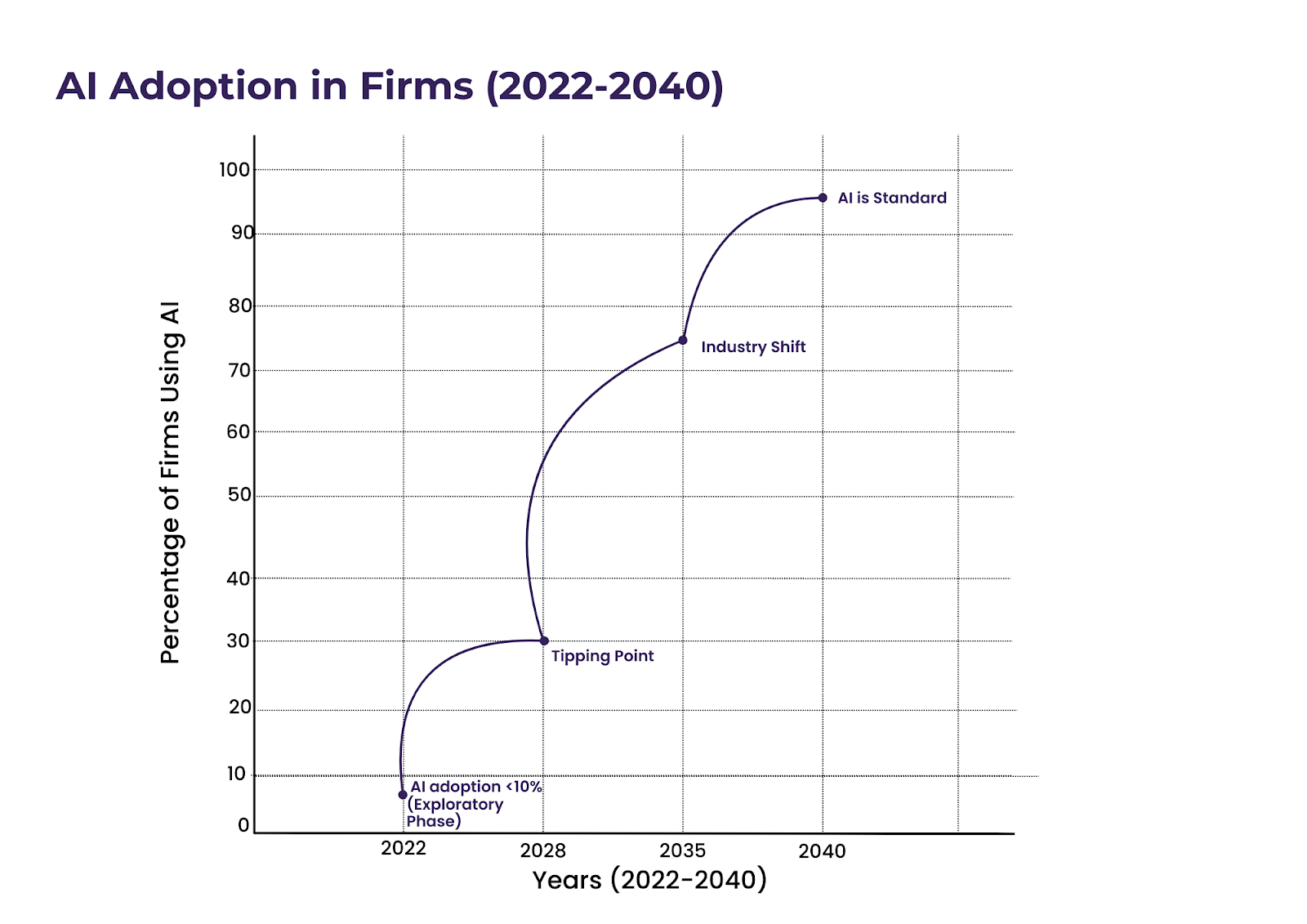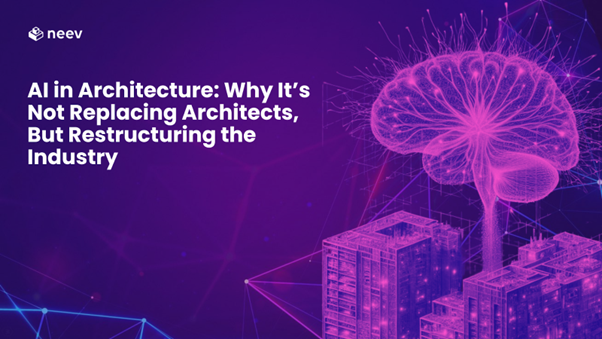Yes, AI is powerful. It’s automating tasks, accelerating iteration cycles, and making workflows more data-driven. But history shows that new technology in architecture takes decades to become standard.
- CAD didn’t replace drafting immediately. It took nearly 20 years (1982-2000s) before firms fully transitioned.
- BIM adoption followed the same slow path. In 2007, only 28% of firms used it. By 2020, it had hit 73%, but even now, not all firms rely on it.
- AI is following the same trajectory. As of 2024, only 24-30% of architecture firms are experimenting with AI tools. At this rate, AI won’t become standard until at least 2035.
So no, AI isn’t replacing architects—it’s restructuring the way they work. The question isn’t if AI will change architecture; it’s how and where it will have the biggest impact.

(some estimates by experts on AI Adoption)
And more importantly—what happens when efficiency starts dictating design?
What the Car Industry Tells Us About AI in Architecture
If you think AI is making architecture more creative, think again.
AI is doing to architecture what computational modeling did to car design.
Back in the 1950s-1970s, car design was diverse—big tailfins, muscle cars, boxy sedans. But once wind tunnel testing, CAD, and fuel efficiency standards took over, that variety disappeared.
- Today, most cars look nearly identical because computational optimization has narrowed design choices.
- The same thing is happening in architecture. AI-driven tools optimize for energy efficiency, material costs, and structural feasibility, which means they keep converging on the same solutions.
Here’s the problem—when you train AI on past architecture, it prioritizes what has already worked, not what’s possible. That’s why:
- 80% of AI-generated buildings are variations of existing models. AI isn’t creating from scratch; it’s remixing past designs.
- We’re already seeing parametric glass towers repeating across cities, just like how modern cars have all started looking the same.
This is not a creativity tool—it’s an optimization engine. And the more AI is used in architecture, the more buildings will start to look like hyper-efficient, data-driven iterations of what came before.
The "Autocorrect Effect"—AI is Repeating, Not Designing
Think about your phone’s autocorrect. It doesn’t write your messages for you—it just predicts the most statistically probable next word.
AI in architecture does the same thing.
- It looks at past building designs.
- It recognizes the most “optimized” solutions.
- It suggests variations based on those patterns.
This is why AI-generated architecture feels familiar—because it’s literally built on past data, not original thinking.
This also means AI struggles with:
- Regional identity & cultural context. If most of its training data comes from Western modernist buildings, will it ever generate vernacular architecture without bias?
- Breaking the rules. Architects sometimes create inefficient forms on purpose to make something experiential, emotional, or human-centered. AI doesn't have that instinct.
- Adaptability to real-world constraints. AI-generated forms often ignore site-specific challenges, local zoning laws, or realistic fabrication limits.
(And just like autocorrect, AI occasionally spits out things that make no sense—unbuildable designs, pointless structural complexity, or aesthetically dull outputs.)

AI’s role in architecture isn’t a question of if it works, but where it works. It’s already excelling in structured, data-driven processes while still struggling in areas that require judgment, creativity, and human intuition. But this divide isn’t fixed—AI is evolving fast, and what it struggles with today might become a strength in the near future.
To understand this, we need to break it down into three areas where AI is already proving indispensable and three areas where it’s still failing to deliver meaningful results.
Where AI is Excelling in Architecture
1. BIM Automation & Clash Detection – Reducing Errors, Improving Coordination
BIM coordination has always been one of the most error-prone aspects of architectural practice. AI is transforming this process, eliminating bottlenecks and reducing the margin for human error.
How AI fits into the workflow:
- AI-powered BIM tools scan models for coordination errors, regulatory compliance issues, and conflicts between disciplines (architecture, MEP, structural).
- Instead of waiting for manual checks, AI automatically flags clashes, significantly reducing late-stage design changes.
- AI-enhanced BIM workflows have cut coordination errors by 35 percent, lowering the need for costly rework.
Why AI excels here:
- Rule-based tasks like clash detection follow strict parameters, making them ideal for AI.
- AI processes and compares massive datasets instantly—something that would take a human team hours or days.
- AI reduces human oversight fatigue, catching coordination issues that might be overlooked manually.
What could change?
- AI might move from detection to resolution, suggesting automatic fixes for clashes instead of just flagging them.
2. AI in Project Scheduling & Risk Forecasting – Smarter Construction Planning
Scheduling a large-scale project is a moving target—weather, labor shortages, material availability, and coordination delays all introduce risk. AI is being used to anticipate these challenges before they escalate.
How AI fits into the workflow:
- AI analyzes historical project data, labor trends, and supply chain patterns to predict risks and recommend the most efficient project sequencing.
- Contractors using AI-driven scheduling tools have reduced labor costs by 10 to 15 percent and optimized material procurement by predicting supply shortages in advance.
Why AI excels here:
- AI works best in data-driven, predictive environments—it identifies patterns and inefficiencies better than humans.
- AI can simulate multiple scenarios simultaneously, allowing firms to test different schedules before committing.
- Risk forecasting prevents project slowdowns, ensuring better cost control.
What could change?
- AI could integrate real-time construction site monitoring, dynamically adjusting schedules based on real-world progress.
3. AI in Feasibility Studies & Early-Stage Design Analysis
Feasibility studies are an essential but time-consuming part of early design. AI is streamlining this process by analyzing site conditions, zoning regulations, and environmental constraints in record time.
How AI fits into the workflow:
- AI scans zoning laws, planning codes, and site constraints to identify viable development options almost instantly.
- What used to take weeks of manual research can now be generated by AI-powered feasibility tools in hours.
Why AI excels here:
- AI can process regulatory data at scale, ensuring compliance early in the design process.
- AI rapidly generates and compares multiple site configurations.
- It reduces wasted effort by eliminating non-viable design options early.
What could change?
- AI may eventually assist in automating permit documentation, accelerating approvals.
Where AI is Struggling in Architecture
1. AI and Creativity – The “Optimization Trap”
AI generates designs based on past data. That makes it a powerful tool for iteration—but not invention. Instead of exploring the unknown, it optimizes for what already exists.
Where AI fits into the workflow (or fails to fit in):
- AI-generated designs are often derivative, reinterpreting existing patterns rather than creating something new.
- AI struggles to balance efficiency with aesthetic, cultural, and experiential intent.
Why AI struggles here:
- AI is pattern-dependent, meaning it produces forms that resemble existing buildings rather than challenging norms.
- AI lacks human intuition—it does not understand why certain spaces feel better than others.
- AI prioritizes efficiency over emotion, often favoring symmetry, repetition, and optimization over conceptual intent.
What could change?
- AI could improve by incorporating real-time user feedback loops, learning from how people experience space rather than just optimizing forms.
2. AI in Human-Centered Design – Struggling with Spatial Experience
AI can generate highly efficient floor plans, but it does not understand how people actually experience space.
Where AI fits into the workflow (or fails to fit in):
- AI-generated master plans often lack warmth, spontaneity, and human-scale consideration.
- AI-generated designs focus on functional efficiency but miss experiential and cultural depth.
Why AI struggles here:
- AI does not perceive scale, atmosphere, or the emotional qualities of space.
- AI lacks contextual awareness—what works mathematically may not work in reality.
- AI cannot interpret behavioral psychology or social dynamics in space-making.
What could change?
- AI could integrate behavioral analytics and real-world spatial feedback to refine its design logic beyond pure optimization.
3. AI and Buildability – The Disconnect Between Form and Fabrication
AI-generated architecture is often visually compelling, but that does not mean it can be built efficiently. Many AI-driven designs fail to account for material constraints, structural logic, or fabrication costs.
Where AI fits into the workflow (or fails to fit in):
- AI creates complex parametric forms that may look interesting but require prohibitively expensive fabrication methods.
- Many AI-generated designs still require extensive manual intervention to make them structurally feasible.
Why AI struggles here:
- AI does not inherently understand construction logic—it generates forms that may be structurally impractical.
- AI prioritizes formal possibilities, often leading to overly complex geometries that increase construction costs.
- The technology does not yet integrate real-time material cost analysis, meaning designs may be beautiful but financially unviable.
What could change?
- AI could evolve to include real-time material performance data and cost estimation, ensuring feasibility during design generation.
The Future: Architects Who Master AI Will Win
Think back to CAD.
The architects who refused to learn it? They struggled. The ones who embraced it? They thrived.
Same with BIM. And the same will happen with AI.
- CAD didn’t kill architecture—it created CAD specialists.
- BIM didn’t eliminate architects—it made BIM coordinators essential.
- AI isn’t replacing architects—it’s creating a new kind of architect.
The firms that treat AI as a tool, not a threat, will gain an edge. The ones that ignore it? They’ll fall behind as AI-assisted workflows become the norm.
So, if you’re wondering where AI is taking architecture, the answer is simple:
It’s not replacing architects.
It’s replacing inefficiency.





